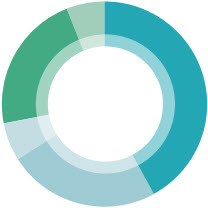Microplate handlers are specialized robotic devices that transfer microtiter plates in three dimensional space from one location within a workflow to another. The “locations” are actually operations such as solvent addition (through liquid handling), aspiration, heating, shaking, incubation, washing, reading, and storage.
Top 6 Questions You Should Ask When Buying a Microplate Handler
- How many plates and plate types can the handler accommodate? An ANSI-compatible handler provides increased flexibility for those using multiple plate densities (ex. 96-, 384-, 1536-well) or low-volume plates, and interchangeable plate stacks accommodate varying throughput requirements.
- What is the transfer speed? Transfer speed is especially important for increased throughput. Adding a dual plate carrier keeps two plates in process, thus further increasing assay efficiency.
- Can the handler operate in portrait and landscape configurations? A rotational gripper option optimizes positioning of the microplate handler with its mating instrument, thus improving flexibility and efficient operation.
- Does the handler fit into a hood or biosafety cabinet? Placing a microplate handler within a hood or biosafety cabinet allows users to maintain personal safety and protect samples.
- Is the handler compatible with a wide variety of other instruments?
- Does it come with a barcode reader for easy microplate identification? Barcode scanning is especially useful for increased throughput.
Types of microplate handler(s) used by survey respondents:
| Microplate reader | 78% |
| Microplate centrifuge | 46% |
| Microplate washer | 32% |
| Microplate stacker | 12% |
| Microplate labeler | 10% |
| Microplate sealer | 8% |
| Other | 8% |
Top 5 microplate handler applications as reported by survey respondents:
| Assay development | 43% |
| Cell biology | 29% |
| Quality control | 25% |
| Bioassay validation | 22% |
| Biomolecule concentration measurement | 22% |
Nearly 44% of respondents are engaged in purchasing a new micoplate handler. The reasons for these purchases are as follows:
 | Replacement of an aging system | 42% |  |
 | Addition to existing systems, increase capacity | 24% | |
 | Setting up a new lab | 6% | |
 | First time purchase | 22% | |
 | Other | 6% |
Top 10 features/factors respondents look for when purchasing a microplate handler:
| Durability of product | 80% |
| Ease of use | 80% |
| Performance of product | 78% |
| Value for price paid | 65% |
| Low maintenance / easy to clean | 61% |
| Low operating costs | 59% |
| Service and support | 59% |
| Total cost of ownership | 58% |
| Warranties | 58% |
| Software | 55% |
For more information on microplate handlers, visit www.labmanager.com/microplate-tech










